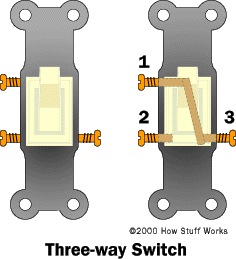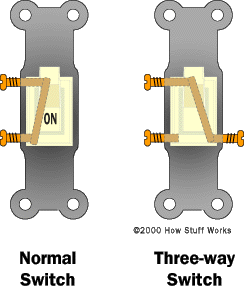Three-Way Lights
To create lights that operate with two separate switches, the electrician uses two special pieces of equipment in the circuit:
- Special switches known as three-way switches
- Special wire that has an extra red insulated wire along with the black and white wires within the sheath
A normal switch has two terminals that are either connected or disconnected. A three-way switch has three terminals, and the switch connects the first terminal to either the second or the third terminal, as shown here:
Advertisement
You use two three-way switches to control the light, and wire it up as shown below:
In this diagram, a normal piece of wire comes from the fuse panel to the first three-way switch. The black "hot" wire enters the switch on the left. Three-way wire(which includes red, black and white wires) runs from the switch on the left to the switch on the right, with the white wire carrying ground and the red and black wires carrying the output from terminals in the left switch. Normal sheathed cable runs from the right switch to the light.

Assume that, with the switch up, terminals 1 and 3 are connected as shown above. If the switch is down, then terminals 2 and 3 are connected. You can see (if you trace through the wires and the switches) that in the previous figure, the light is off. You can also see that if you flip either switch, the light will turn on. And if you flip either switch again, the light will turn off. It is actually a very simple arrangement once you see it all exposed like this!
There are several other ways to wire three-way switches to a light. For example, the power from the fuse box could come in at the light fixture and there could be two switches in series running from there. Or power can enter at the fixture and then two switches can be arranged in parallel from the light.
If you are trying to understand how a set of switches are wired in your house, using an ohmmeter or a continuity detector is the only way to reverse-engineer what the electrician has done (make sure you turn the power off at the fuse panel before doing anything with electrical wiring). The great thing is that, if you know the basic idea behind three-way switches and three-way wiring, it's really easy to figure it out. And if you simply want to understand what's going on to satisfy your own curiosity, well, now you know!
For more information on three-way switches and related topics, check out the links below.
